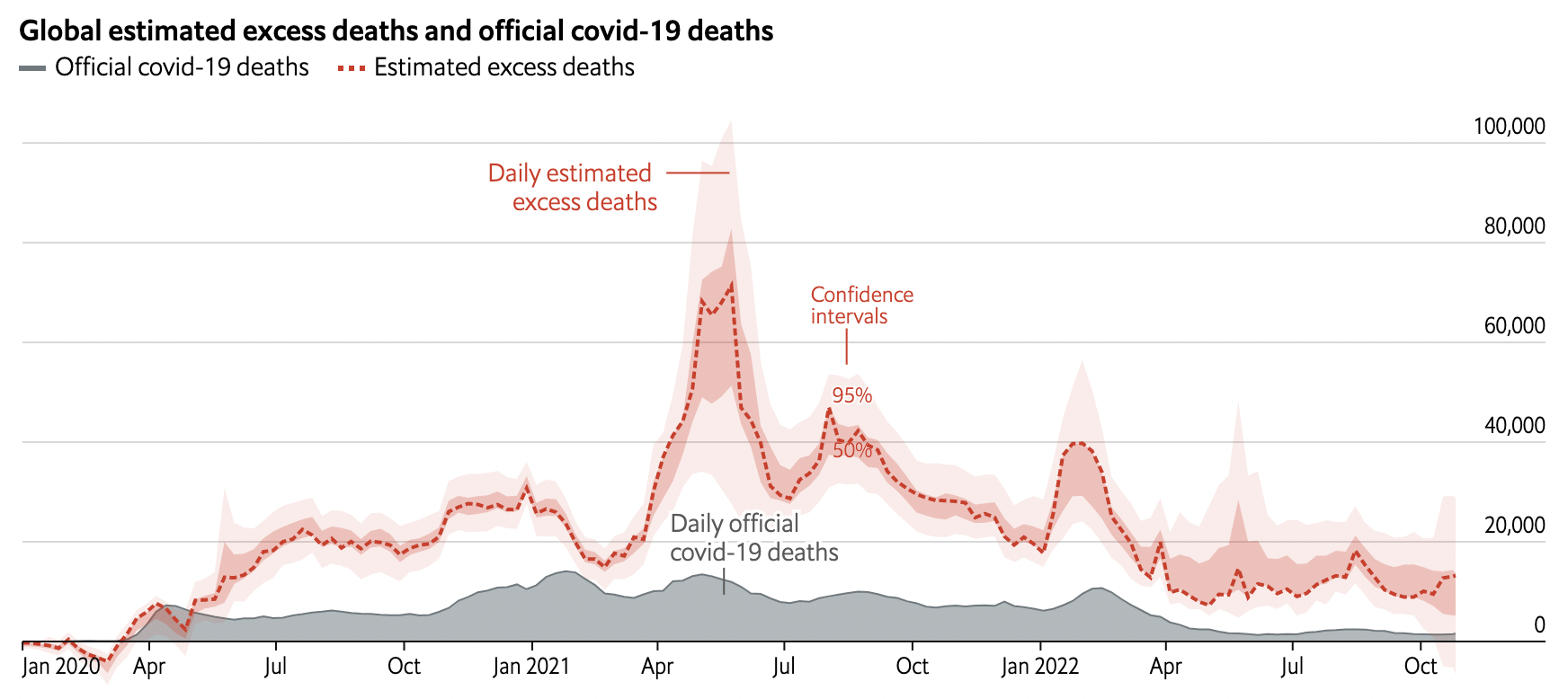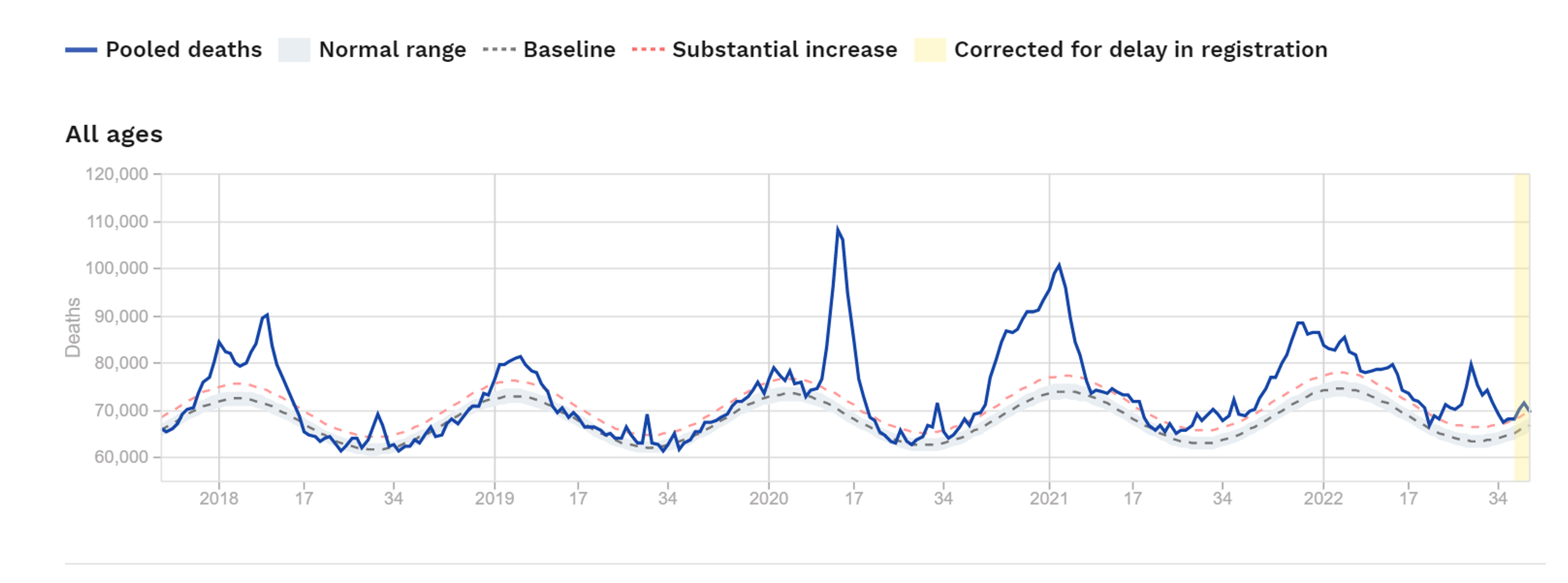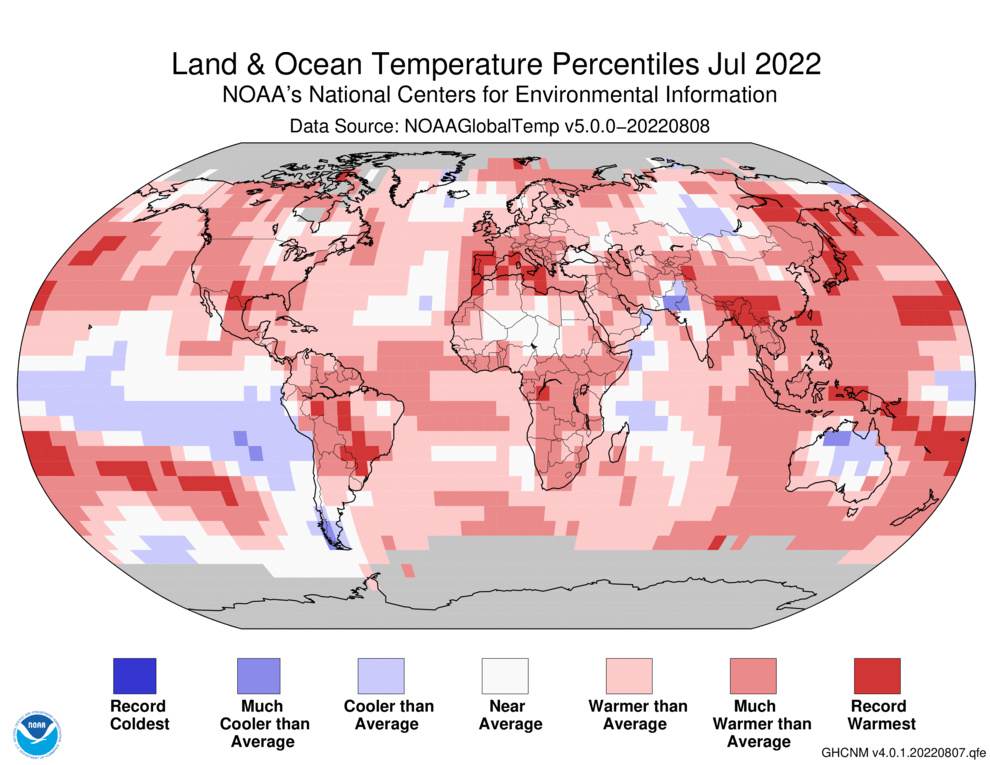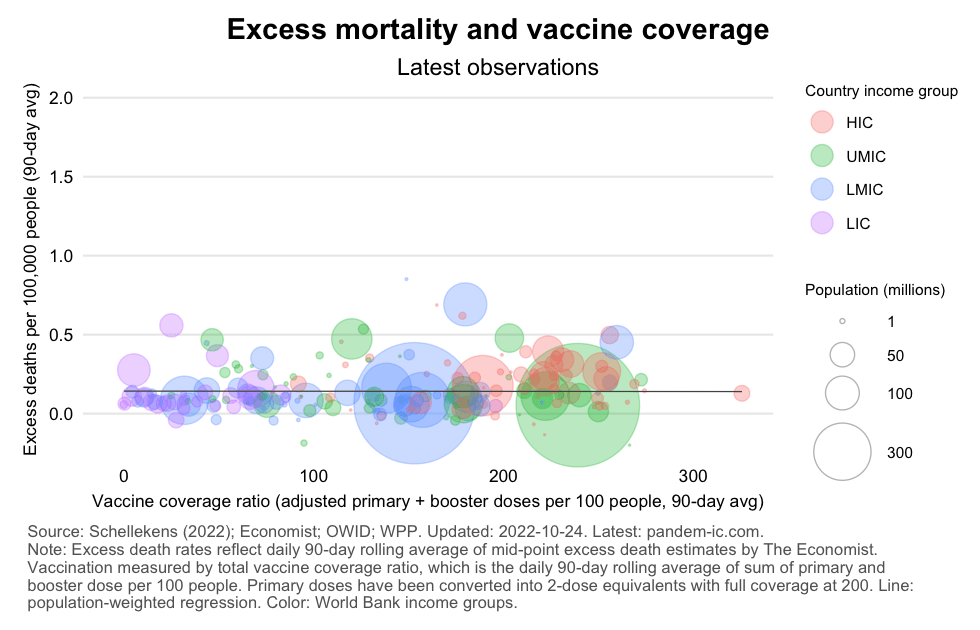
image source
Introduction
Every day, people die of many causes: diseases, accidents, violence, or simply old age. The number of deaths in any given country is usually stable from one year to the next. It is thus possible to estimate how many people are expected to die the following year. While changes in a country’s demography, economy or healthcare system affect nationwide mortality, such changes are slow to take effect and their consequences typically become apparent only after longer periods.
However, catastrophes—such as wars, natural disasters or diseases—can cause many more people to die than expected under normal circumstances. This phenomenon is called excess mortality. It’s the number of deaths beyond what would be normally expected. An observation of excess mortality can be a signal that something is wrong.
Excess mortality is also a good indicator of the actual impact of a crisis on the population. For example, a war can kill people in many ways: direct combat, food shortages or unmet health needs because of the destruction of essential infrastructure and saturation of hospitals. If we only counted the number of combat casualties, we would underestimate the real toll of the war. But comparing how many people died during wartime to how many people used to die during peacetime can give us a good idea of how much impact the conflict had on the country.
We can estimate excess mortality by comparing the actual number of deaths in a given month to the historical average of deaths during the same month for the previous years, or by using more sophisticated statistical modeling. Differences in excess mortality counts from one source to another can arise due to the use of different calculation methods.
It should come as no surprise that excess mortality has been a feature of the COVID-19 pandemic. Using machine learning algorithms, The Economist estimated that there were between 16.8 and 28.1 million excess deaths from all causes since the onset of the pandemic. This illustrates the significant toll the pandemic has taken on the world.
However, COVID-19 deaths gradually decreased throughout 2022. With the threat of the disease appearing to diminish, COVID-19 stopped hitting the headlines and most countries lifted their restrictions on daily life. But this gradual return to normalcy belies the fact that excess mortality has continued to persist in many countries well into 2022. This observation has surprised many commentators and journalists. The trend has also become fodder for COVID-19 vaccine skepticism.
Understanding why this excess mortality persists can be difficult. This is because there could be many contributing factors involved, adding to complexity. Furthermore, researchers are still in the process of collecting and analyzing data for 2022, making it too early to arrive at any definitive explanations.
But we do know that there were certain notable events in 2022 that could explain, at least in part, the persistent excess mortality. This Insight article aims to discuss these events and how they could have increased the mortality rate in the second half of 2022.
Contents of this article
- The summer of 2022 showed a noticeable excess mortality, but this was lower than in 2020 and 2021
- COVID-19, heat waves, healthcare backlogs: several potential contributors to excess mortality
- COVID-19 vaccines aren’t responsible for the excess mortality of 2022
- Conclusion
The summer of 2022 showed a noticeable excess mortality, but this was lower than in 2020 and 2021
The summer of 2022 showed a noticeable excess mortality, but this was lower than in 2020 and 2021
As Figure 1 below illustrates, most countries in the world continue to experience greater mortality than expected in 2022.

Figure 1. Estimate of the daily excess mortality per 100,000 people in 2022. Only countries in blue exhibited a level of mortality that was below expected. All other countries experienced excess mortality. Source: The Economist.
As the map above shows, excess mortality doesn’t only occur in medium- and lower-income countries, but also North America and Europe.
For instance, the U.S. Centers for Disease Control and Prevention (CDC) reported excess mortality almost every week since mid-May 2022, as illustrated in Figure 2 below.
During the second half of 2022, the weekly number of deaths in the U.S. represented an excess of 5 to 12% above the expected mortality. That said, this excess mortality is much smaller than the excess mortality registered between April 2020 and February 2021, as well as August 2021 to February 2022. This observation is in line with The Economist’s report (Figure 1) that the U.S., like other countries, is experiencing a prolonged period of excess mortality, albeit to a much lower extent than during the peaks of the COVID-19 pandemic in 2020 and 2021.

Figure 2. Weekly mortality in the U.S. reported by the CDC as of October 2022. The red line marks the upper bound of the threshold for expected deaths, above which more deaths than expected have been registered. Weeks of excess mortality are indicated by a red cross.
Statistics from Europe also indicated greater than expected mortality during the second half of 2022. The European Mortality Monitoring project (EUROMOMO) reported that the number of deaths has been larger than usual since early June 2022 (Figure 3). As with the U.S., we can see that excess mortality during the second half of 2022, although evident, is lower than excess mortality during previous COVID-19 waves.

Figure 3. Excess mortality in Europe registered by EUROMOMO as of October 2022. The dotted red line indicates the threshold above which the mortality is in excess. The blue line represents all-cause mortality.
The statistical office of the European Union, Eurostat, which used a different statistical method from EUROMOMO, also registered excess mortality during the summer of 2022.
Eurostat also reported that excess mortality was higher in the summer of 2022 than in the summers of 2020 and 2021: excess mortality was 3% in July 2020 and 6% in July 2021, representing 10,000 and 21,000 excess deaths. But that number hit 16% in July 2022, corresponding to 58,000 more deaths than expected.
August followed the same trend, with 12% excess mortality in August 2022, in contrast to 6% in August 2020 and 8% in August 2021.
Here as in the U.S., the peak of excess mortality in the second half of 2022 is clearly lower than the peaks in 2020 and 2021. The U.K. exhibited a similar trend, with a noticeable excess mortality in the summer of 2022, albeit to a lesser extent than in 2020 and 2021, than occurred in winter.
Overall, these statistics indicate that excess mortality numbers have improved in both the U.S. and Europe in 2022. However, this excess mortality during the summer months has drawn media attention, since it hasn’t occurred before, either during the pandemic or during the summer of 2018 and 2019.
How can this observation be explained? In the next sections, we will discuss the complexity involved in this question and delve into some possible causes of excess mortality.
COVID-19, heat waves, healthcare backlogs: several potential contributors to excess mortality
COVID-19, heat waves, healthcare backlogs: several potential contributors to excess mortality
Determining the exact causes of the persistent excess mortality is difficult, because there can be many different factors increasing a population’s mortality rate in direct and indirect fashion.
For example, during a war, people may be directly killed in action. But they may also die later from malnutrition, injuries, or suicide due to post-traumatic stress disorder. In the latter cases, the war didn’t directly cause the deaths, but fostered an environment that increases the likelihood of other fatal events.
As a result, identifying the root cause of wartime deaths can be more difficult and require more research and analysis. The same type of complexity is also involved when trying to understand excess mortality in the context of a pandemic and its aftermath, as we will see below.
COVID-19
Even though COVID-19 is slowly fading from news headlines, the pandemic isn’t over yet. In September 2022, officials from the World Health Organization (WHO) declared that the end of the pandemic was “in sight,” but that it was still too soon to call it a thing of the past.
Indeed, several variants of the SARS-CoV-2 virus are still circulating, and increased viral load detected in wastewater from some parts of the U.S. suggests that transmission may be on the rise in the country in the summer of 2022.
People also continue to die from COVID-19. In fact, the U.S. registered a spike in COVID-19 deaths in the summer of 2022, albeit a smaller one than previous peaks. According to the CDC’s data shown in Figure 4, 28,591 deaths involved COVID-19 between July and August 2022. At the same time, there were 38,687 excess deaths. Thus, most of the excess mortality in the summer of 2022 comprises deaths linked to the disease (74%).

Figure 4. Weekly mortality in the U.S. registered by the CDC as of October 2022. The red line marks the upper bound for the threshold of expected deaths; deaths above this line signify excess mortality. Weeks of excess mortality are indicated by a red cross. The deaths in blue are those due to COVID-19. The deaths in green are those not attributed to COVID-19.
In the European Union, Eurostat registered 58,000 excess deaths in July and 42,000 in August this year. But there were some who suggested that these excess deaths weren’t due to COVID-19. For instance, retired nurse educator and YouTuber John Campbell claimed that the excess deaths in July is “16% above what we had at pre-pandemic levels, for non-COVID related deaths at the moment”.
However, the European Center for Disease Prevention and Control (ECDC) counted 18,188 COVID-19 deaths in July and 16,447 in August. Taken together, this means that 31 to 37% of excess deaths are due to COVID-19.
England also faces a similar situation. Comparing numbers for total deaths, expected deaths, and deaths involving COVID-19 from the Office of Health Improvement and Disparities show that COVID-19 deaths represented 31 to 67% of excess mortality in July and August 2022.
These facts contradict claims that COVID-19 had a very limited contribution to the excess mortality made by Campbell. Indeed, Campbell alleged that “deaths involving COVID-19 accounted for 3.4% of all excess deaths” in the week ending 2 September 2022.
But official data actually showed that COVID-19 deaths (314 in England and Wales) represented 3.4% of the total number of deaths this week (8,868), but accounted for 46% of the total number of excess deaths (675), which falls within the range we mentioned above.
For example, there were 10,322 registered deaths in the week ending 29 July 2022. In the same week, the expected number of deaths based on pre-pandemic data was 8,765. Therefore, the number of excess deaths that week was 1,557 (registered deaths minus expected deaths). Among these excess deaths, 776 were registered as COVID-19 deaths (49.8%).
Altogether, these findings highlight COVID-19 as a significant cause of death in the summer of 2022 in the U.S., the European Union, and the U.K. Therefore, despite the diminishing media attention paid to the virus, COVID-19 continues to contribute to excess mortality observed in these regions.
Heat waves
Record-breaking heat waves and droughts marked the summer of 2022 in many places worldwide (Figure 5). For example, London broke its all-time temperature record in July, as did the state of Texas. Heat waves swept Asia, Europe, and America. Belgium also set a new national temperature record in August.

Figure 5. Percentiles of Earth surface temperature in July 2022 represented using colors. Red represents regions where the temperature in July 2022 was higher than the average temperature for that month. Source: National Oceanic and Atmospheric Administration.
However, data on summer heat waves in 2022 are still preliminary. This means that at the moment, we can’t determine with certainty if and how the 2022 heat waves increased mortality above the expected range. But research shows that excess heat can lead to more deaths[1-3].
Heat can kill directly by causing heat stroke, or indirectly by aggravating pre-existing medical conditions, such as heart disease. Newborns and the elderly, who can’t regulate body temperature very well, are particularly vulnerable to heat waves. It is thus plausible that the 2022 heat waves did contribute to the excess deaths during that summer.
In fact, Spain already recorded 5,829 heat-related deaths, mostly in July and August. This is higher than the heat-related mortality of recent years, estimated at around 3,000 deaths per year. In France, the national statistics office noted that deaths peaked during each heat wave throughout the summer. Similarly, the U.K. Health Security Agency reported 2,803 excess deaths that were possibly due to heat-related complications during the heat waves in July and August 2022.
Because data are still preliminary, and because heat can indirectly increase the risk of dying from other causes, it is difficult to clearly establish a causal association between heat waves and deaths. Nevertheless, the fact that the heatwaves and peaks of mortality occurred at the same time—combined with research findings on mortality during past heat waves—strongly suggest that the abnormally high temperatures in the summer of 2022 also contributed to excess mortality.
Disruption to healthcare systems
The COVID-19 pandemic disrupted healthcare systems in many countries, leading to delays in delivering patient care. Hospitals faced a surge in COVID-19 patients, some of them critically ill. This required hospitals to allocate a greater share of their resources and staff to COVID-19 patients, sometimes to the detriment of other medical services and departments.
As a consequence, hospitals had to postpone important but less urgent medical procedures, such as preventive medical exams and elective surgery. Fear of infection also aggravated the problem, with many patients avoiding going to hospitals.
A study across several countries found that cancer screening, tuberculosis testing, maternal health services, and outpatient visits were all disrupted during the pandemic. Child vaccination campaigns were also interrupted[4]. The WHO also found that almost every country in Europe is enduring healthcare disruptions, evidenced by longer patient waitlists—the number of patients waiting to receive specific treatments—and treatment delays.
Many U.S. hospitals also faced similar challenges. Hospitals in 40 states reported critical staffing shortages and a staffing pool that has shrunk from pre-pandemic levels, which impacts the ability of the healthcare system to properly meet the needs of the population.
Furthermore, a study on Medicare hospital admissions from April 2020 to September 2021 in the U.S. found that the mortality risk of non-COVID-19 patients was actually higher than before the pandemic. One possible explanation is that hospitals lacked critical resources such as ICU beds, because resources were reallocated for COVID-19 patients[5].
As illustrated above, there’s plenty of evidence showing how the pandemic heavily impacted healthcare systems in 2020 and 2021. But what about the situation in the second half of 2022? As of writing, it’s too early to draw a clear picture of healthcare systems in summer 2022 and conclusively determine the impact on excess mortality.
But there are signs that things aren’t back to normal yet. For example, the U.K. National Health Service (NHS) is still experiencing a patient waitlist longer than in 2019 and which is still growing throughout the summer of 2022. The average waiting time has also continued to increase.
Overall, these observations suggest that healthcare systems in the U.S. and Europe have suffered from major disruptions due to COVID-19 and have yet to recover. This means that people are likely to keep facing difficulties in obtaining care. And it’s plausible that people in need of diagnosis or treatment will be at a higher risk of dying due to the delays.
COVID-19 vaccines aren’t responsible for the excess mortality of 2022
COVID-19 vaccines aren’t responsible for the excess mortality of 2022
Unsurprisingly, reports of excess mortality well into 2022 became fodder for claims by vaccine-skeptic groups that mass vaccination against COVID-19 was responsible for this increase in deaths (see here and here for examples of such social media posts). An article by the website The Exposé, published at the end of November 2022, claimed that “at least 118k children and young adults have ‘died suddenly’ in the USA” and that this was “most likely due to the Covid-19 injections”.
This is a variation of the recurring false allegations that COVID-19 vaccines are unsafe and deadly that Health Feedback debunked on multiple occasions (see here, here, and here). As we’ll show below, the claims linking vaccination to excess mortality are baseless.
To begin with, COVID-19 vaccines have been extensively tested, both during clinical trials and in real-world settings, without showing any significant vaccine-associated deaths that would explain the persistent excess mortality we’re seeing now.
Furthermore, the comparison of vaccine coverage and excess mortality numbers doesn’t suggest an association between them. If vaccination caused mortality to increase, we would expect to observe two correlations. The first is that the higher the vaccination coverage, the higher the excess mortality; the second is an increase in the number of all-cause deaths as the vaccination campaign progresses.
Before going any further, we must clarify two points. The first is that even if a correlation between vaccination coverage and excess mortality exists, this alone would be insufficient to claim that vaccination is responsible for the excess deaths. Indeed, correlation alone isn’t enough to prove causation, as Health Feedback previously explained.
However, this isn’t to say that correlation doesn’t matter at all. This brings us to our second point: if there is an absence of correlation between vaccination coverage and excess mortality, then this will strongly speak against those claims, providing that the analysis was properly designed to exclude confounding factors. Put simply, correlation is necessary but not sufficient for explaining causality.
The website pandem-ic.com, run by Philipp Schellekens, an economic advisor at the World Bank, compared the vaccination coverage of world countries with their excess mortality. As shown in Figure 6, there was no correlation between vaccination coverage and excess mortality over the period between August and October 2022.

Figure 6. Correlation of the excess mortality and the vaccination coverage in the world’s countries during the August to October 2022 period. Excess mortality data was derived from The Economist’s excess mortality tracker. Vaccination coverage data was obtained from the site Our World in Data, which gathers data from health authorities across the world. Excess mortality was expressed as a proportion of a country’s population size. Both variables are expressed as 90-day rolling averages in order to smooth out short-term variations that are irrelevant to the bigger picture. Each country is represented by a circle proportional to its population size. Countries are divided and color-coded into four levels of incomes. Source: Phillipp Schellekens.
Thus Figure 6 shows that having a greater proportion of vaccinated people in the population isn’t associated with an increase in excess mortality. This contradicts the claim that COVID-19 vaccines are responsible for the excess deaths.
We can also look at how excess mortality evolves in individual countries and see how this compares with vaccination coverage (Figure 7). The graphs below compare the excess mortality with the proportion of fully vaccinated individuals in the population, both in the U.S. and the U.K., two countries that we discussed throughout this article.

Figure 7. Changes in excess mortality and vaccination coverage over time in the U.S. and in the U.K. Excess mortality is calculated as the difference between the cumulative registered all-cause deaths starting from 1 January 2020 and the cumulative number of expected deaths over the same period. On the graph, the difference is shown as a percentage of the cumulative number of expected deaths. More details here. The expected number of deaths is an estimate based on 2015-2019 mortality data. Source: Our World in Data.
In both countries, excess mortality spiked at the onset of the COVID-19 pandemic. In the U.S., excess mortality reached a plateau towards the end of 2021. In addition, the increase in vaccination coverage wasn’t accompanied by any further increase in excess mortality.
Furthermore, excess mortality has generally been trending downward since mid-2020 and the vaccination campaign wasn’t associated with a reversal of that trend. If COVID-19 vaccines had caused an increased risk of death, we would have seen the opposite instead.
Consistent with this, an analysis from the CDC comparing the non-COVID-19 mortality of vaccinated and unvaccinated individuals found that vaccination doesn’t increase the risk of dying from any cause[6].
Altogether, the data contradict the claim that COVID-19 vaccines are responsible for excess mortality. So far, proponents of this claim have failed to bring forth any supporting evidence. As such, this claim is baseless.
Conclusion
Conclusion
Understanding the excess mortality observed in 2022, especially during its second half, is challenging. This is because there can be multiple independent factors contributing to a higher mortality rate and they may contribute indirectly to the mortality in various ways. In addition, the phenomenon is still very recent at the time of writing and researchers are still in the process of collecting and analyzing mortality data from summer 2022.
However, based on the data we do have, we can already identify some likely contributing factors to this persistent excess mortality.
First, the virus SARS-CoV-2 is still circulating and epidemiological data show that COVID-19 deaths still represent a significant part of the excess mortality.
Second, the exceptional heat waves in July and August 2022 are likely to have increased the risk of death, as excess heat can lead to death directly or indirectly.
Third, the healthcare systems of many countries are still reeling from the COVID-19 pandemic. Many hospitals remain underfunded, underequipped, and understaffed, leading to suboptimal care for patients.
But one thing we do know isn’t contributing to excess mortality is COVID-19 vaccines, contrary to claims by some. As we demonstrated earlier, there’s no correlation between vaccination coverage and the amount of excess mortality, nor is excess mortality positively correlated with the deployment of public COVID-19 vaccination campaigns. Therefore, the evidence available contradicts this claim.
UPDATE (6 Dec. 2022):
This review was updated to include an example of an article published by The Exposé which claimed that COVID-19 vaccines were responsible for excess deaths.
UPDATE (28 Nov. 2022):
This review was updated to emphasize that official mortality data show a significant contribution of COVID-19 deaths in the total of excess deaths in the UK in 2022, contrary to what has been claimed. The text has also been updated to explain under which conditions the absence of correlation speaks strongly against the existence of causality.
REFERENCES
- 1 – D’Ippoliti et al. (2010) The impact of heat waves on mortality in 9 European cities: results from the EuroHEAT project. Environmental Health.
- 2 – Khatana et al. (2022) Association of Extreme Heat With All-Cause Mortality in the Contiguous US, 2008-2017. JAMA Network Open.
- 3 – Zhao et al. (2021) Global, regional, and national burden of mortality associated with non-optimal ambient temperatures from 2000 to 2019: a three-stage modeling study. The Lancet Planetary Health.
- 4 – Arsenault et al. (2022) COVID-19 and resilience of healthcare systems in ten countries. Nature medicine.
- 5- Dang et al. (2022) Hospitalizations and Mortality From Non–SARS-CoV-2 Causes Among Medicare Beneficiaries at US Hospitals During the SARS-CoV-2 Pandemic. JAMA Network Open.
- 6 – Xu et al. (2021) COVID-19 Vaccination and Non–COVID-19 Mortality Risk — Seven Integrated Health Care Organizations, United States, December 14, 2020–July 31, 2021. Morbidity and Mortality Weekly Report.
